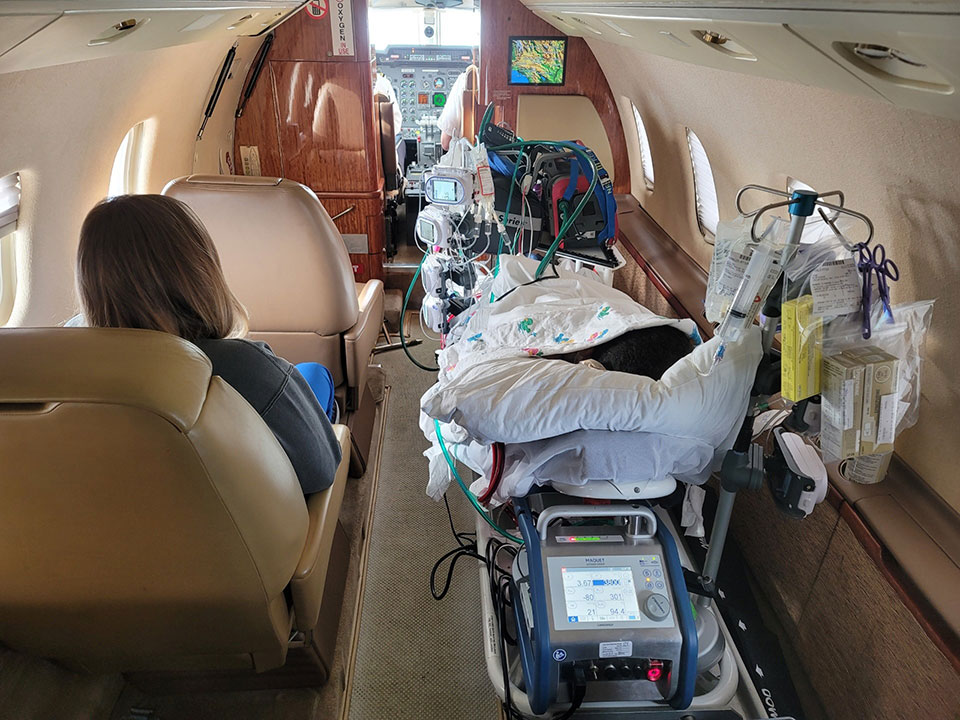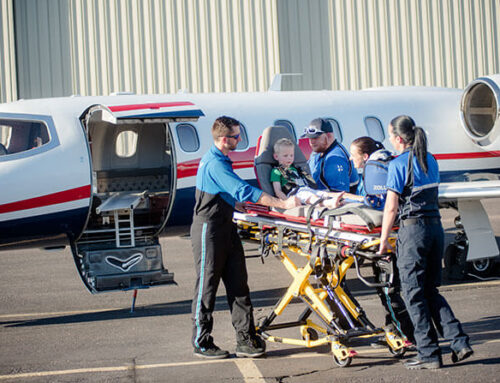Air Ambulance services are required when a patient has a medical injury or illness and needs to be transferred to another location for further medical care. Long-range transports are transfers from state to state, to or from another country outside of the US, or any distance where specialized care is necessary. These transfers are carried out in larger fixed-wing aircraft, versus a rotor aircraft, that are medically configured to act as an airborne ICU and can transport the patient safely, comfortably, and quickly. Long-range Air Ambulance aircraft are professionally staffed with an experienced medical crew to provide care for the patient while being transferred in between medical facilities.
There are 5 critical patient vital signs that the medical crew constantly monitors and addresses during transport in the air and on the ground to and from the aircraft. Those vital signs are Heart Rate, Respiratory Rate, Blood Pressure, Oxygen Saturation (Sp02), and Pain. When pain increases and is not addressed properly it further effects multiple patient conditions. Pain and pain control is often the reason that long range medical air transport is utilized versus placing the patient on a commercial aircraft. Below we highlight the importance of pain management in a long-range environment.
How does pain effect and relate to long range medical transport?
Transporting patients involves multiple patient movements and transfers prior to arrival at the Air Ambulance aircraft. Along with the multiple moves, patients are often already anxious and nervous about the process. If the patient is already in pain, paired with anxiety it can cause the body to respond in a negative way. All patients feel pain no matter the acuity of the condition, therefore pain management is a top priority in all patient populations ranging from NICU babies to intubated and sedated critical patients, all the way to end-of-life hospice patients using a hospice air transport.
What do we do to address Pain?
When addressing pain, we start with a baseline and then continue with patient assessments along the transport. Each patient has a different pain tolerance and responds in different ways. It is critical to know the baseline pain and to not let the pain get uncontrolled prior to it being first addressed.
While AirCARE1 utilize a holistic approach to medical care, there are three ways to help manage pain with our patients during an air medical transport:
- Physical Exercise – If possible, we promote exercise and body movement on the aircraft to allow for improved circulation and increased range of motion. Paired with repositioning, stretching, and hand massages we can reduce pain.
- Mental Health – It is equally important to lower patient stress levels internally by helping our patients reach a mental state of peace that can decrease pain from within. We provide noise cancelling headsets to block ambient noises, combined with calming music we can stimulate the brain and create a relaxation response that smooths respiration, reduces heart rate, and lowers blood pressure. We add in aroma therapy that can motivate the limbic system to regulate stress, and trigger positive memories, hormones, and breathing. All of these physical responses can calm our patients and decrease pain.
- Medication – Administering medication plays a key role in managing pain, and building a specific treatment plan for each patient is vital to properly manage pain. Patient history, medication history, and medication tolerance are three vital components that aid in building a medication plan. Our extended list of pain medications includes Advil, Tylenol, Tordol, Morphine, Fentanyl and Ketamine. We consistently revise and update our pain protocols using evidence-based practice.
Paint Management Patient Case Study
Scenario:
60’s year old female, Canadian citizen, enjoying a vacation in Mexico when she had a ground level fall. She was taken to a local Mexican hospital where x-ray revealed a femoral head fracture needing orthopedic surgical intervention.
Barriers to Definitive Patient Care:
Her Canadian health plan is requiring surgery be performed in Canada, there are no hospitals near her location able to provide the surgery, the flight time to Canada is 4 ½ hours, the hospital is located 35 miles from the airport on dirt roads with heavy traffic. This leaves the resounding barrier to patient care being Pain.
Patient Transport Details:
Upon arrival to the hospital the patient was very anxious about the entire transport. She had not been ambulated since her injury. There was a long leg splint in place with distal pulses present. Our Medical crew decides to place a foley catheter due to increased pain upon movement. There was a notable improvement to anxiety once bladder was empty. Discussion for pain plan took place. This plan included position of comfort with leg along with the need for multiple repositions of patient throughout transport. Plan to give patient Morphine or Fentanyl on a scheduled period, as needed, and prior to each move. The ground ambulance transport time was 45 minutes, followed by 1 hour in customs at the Mexican airport. After takeoff we were able to address and keep pain at a very manageable level by following our pain plan. Once on the ground in Canada after another 45 minutes customs stop, and a 30-minute ground ambulance ride we arrived at the hospital. With over 8 hours of total patient transport time, pain control was our leading objective. Surgery took place the following day and the patient is doing well; she plans to go right back to traveling after she is fully recovered.




